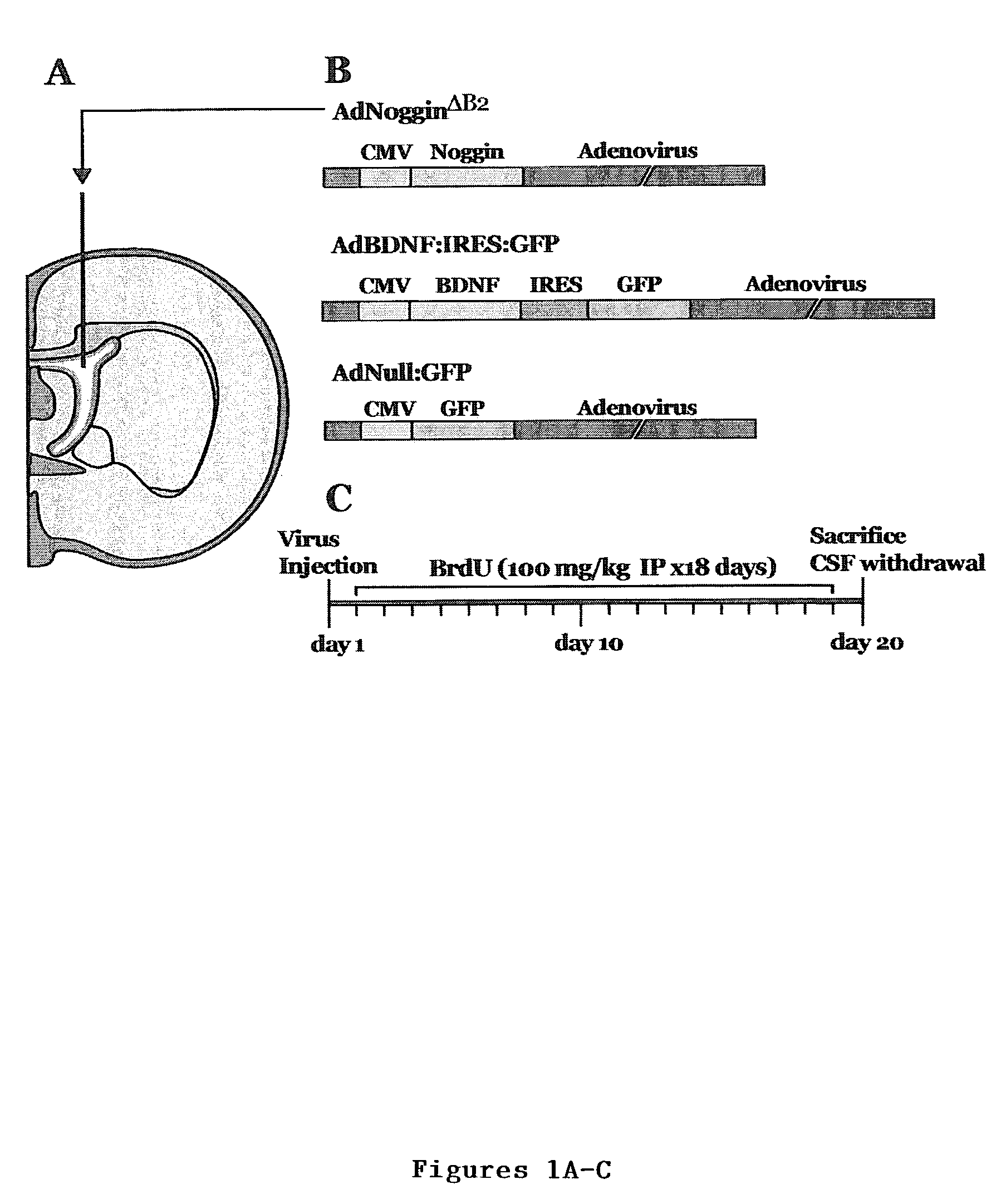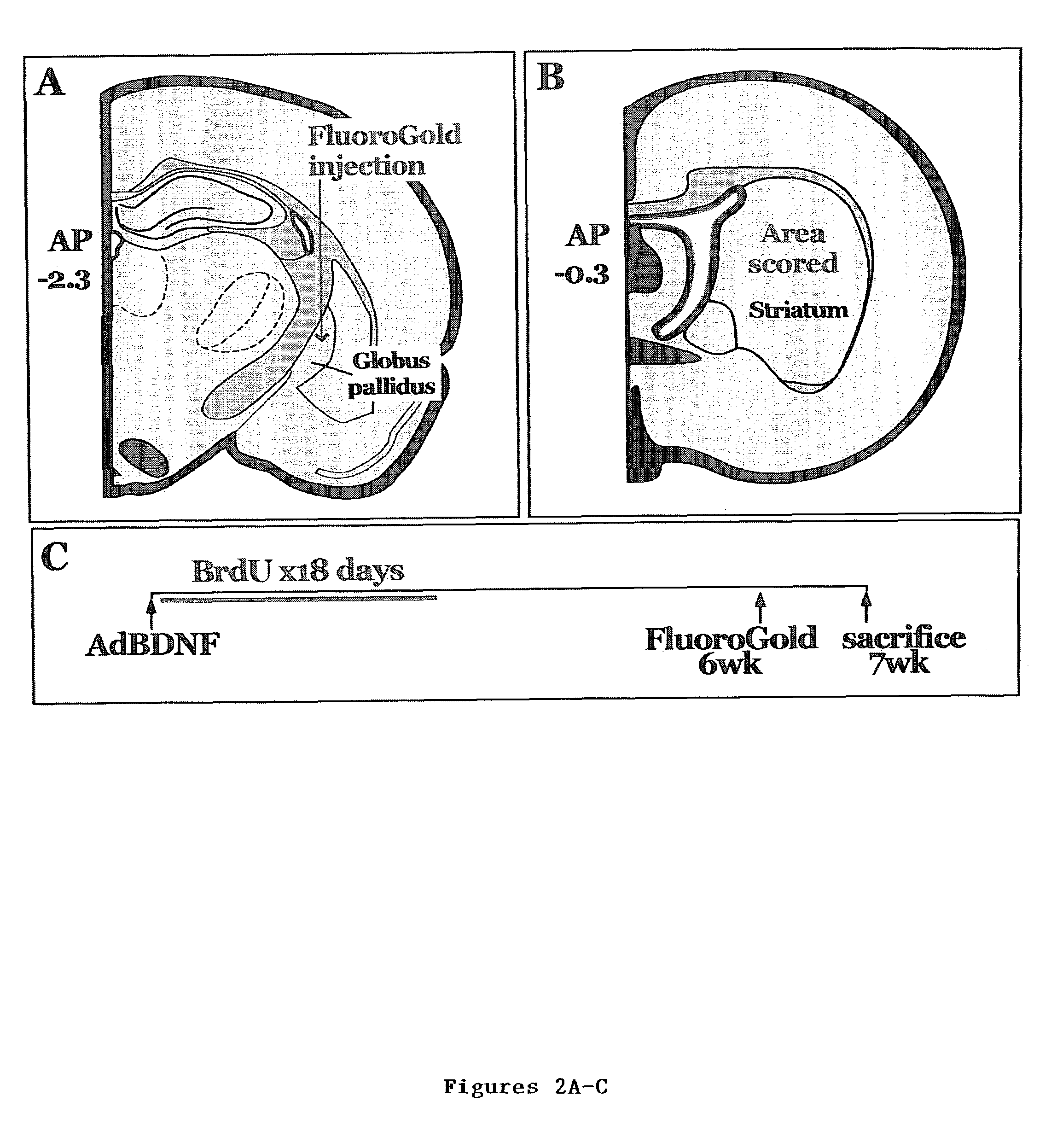Enhancing neurotrophin-induced neurogenesis by endogenous neural progenitor cells by concurrent overexpression of brain derived neurotrophic factor and an inhibitor of a pro-gliogenic bone morphogenetic protein
a neurotrophin and endogenous neural technology, applied in the direction of dsdna viruses, animal repellents, peptide/protein ingredients, etc., can solve the problems of chronic ventriculostomy infection and catheter loss, and the inability to effectively prevent or reduce the degeneration of most of the above-mentioned classes of affected neurons
- Summary
- Abstract
- Description
- Claims
- Application Information
AI Technical Summary
Benefits of technology
Problems solved by technology
Method used
Image
Examples
example 1
Adenovirus Construction
[0077]Replication-incompetent AdBDNF and AdNull were constructed and raised as previously described (Benraiss et al., J Neurosci 21:6718-31 (2001), which is hereby incorporated by reference). Using the same previously described techniques (Benraiss et al., J Neurosci 21:6718-31 (2001); Bajocchi et al., Nature Genetics 3:229-234 (1993); and Graham et al., In Methods in Molecular Biology, ed. Murray, E. (Humana, pp. 109-128 (1991), which are hereby incorporated by reference in their entirety), a ΔE1 type 5 adenovirus was made to encode, under CMV control, human nogginΔB2, from which the B2 heparin binding domain had been deleted, yielding AdNogginΔB2 (Paine-Saunders et al., J. Biol. Chem (2001) and Economides et al., Moraga, Calif. (2000), which are hereby incorporated by reference in their entirety).
example 2
Experimental Design and Sterotaxic Injection
[0078]In the first set of experiments, six adult Sprague-Dawley rats received bilateral 3 μl intraventricular injections (Benraiss et al., J Neurosci 21:6718-31 (2001) and Paxinos et al., The Rat Brain in Stereotaxic Coordinates (Academic, Orlando, Fla.) (1986), which is hereby incorporated reference in their entirety) of AdNogginΔB2 (n=3) or AdNull (n=3). Both viruses were titered to 2.5×1010 pfu / ml. In the second set of experiments, AdNogginΔB2 and AdBDNF were both brought to a titer of 2.5×1010 pfu / ml within the same solution, and 3 μl of this cocktail were injected intraventricularly (n=3). Matched controls received AdNull (n=3). The rats were then given 18 daily i.p. injections of bromodeoxyuridine (BrdU; 100 mg / kg). On day 20 or 56, animals were sacrificed, CSF withdrawn and brains processed as previously described (Benraiss et al., J Neurosci 21:6718-31 (2001), which is hereby incorporated by reference in its entirety). Additionally...
example 3
ELISA
[0079]Noggin levels in the CSF were determined with a two site ELISA using two rat-derived anti-human noggin monoclonal antibodies. Coat Antibody RP57-16, which binds at the N-terminal half of noggin, was coated at 2 μg / ml in PBS, followed by an incubation with 10 mg / ml BSA solution in PBS for 2 hours to block any free protein-binding sites. On the ELISA plate, serial 2-fold dilutions of a known concentration of noggin protein were performed in triplicate, and CSF samples were added. 100 μl of a 1 μg / ml solution of the anti-noggin biotinylated monoclonal RP57-21-biotin, which binds to the cysteine-rich domain of noggin, were added to each well. To detect RP57-21-biotin the plates were then incubated with a streptavidin-HRP conjugate (Life Technologies) at a 1:5000 dilution, for 1 hour.
PUM
 Login to View More
Login to View More Abstract
Description
Claims
Application Information
 Login to View More
Login to View More - R&D
- Intellectual Property
- Life Sciences
- Materials
- Tech Scout
- Unparalleled Data Quality
- Higher Quality Content
- 60% Fewer Hallucinations
Browse by: Latest US Patents, China's latest patents, Technical Efficacy Thesaurus, Application Domain, Technology Topic, Popular Technical Reports.
© 2025 PatSnap. All rights reserved.Legal|Privacy policy|Modern Slavery Act Transparency Statement|Sitemap|About US| Contact US: help@patsnap.com



